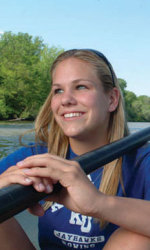A.D.'s Corner
Oct. 13, 2006
We all marvel at the tremendous skill of college student-athletes as they gracefully – and sometimes forcefully – execute feats most of us can only dream about performing. But only a few people are really aware of the extreme physical demands placed on student-athletes at the Division I level.
Because of those demands, Kansas Athletics wants to do everything possible to help ensure the health of these young men and women. That is why, back in 2004, we instituted a comprehensive cardiac screening program for incoming student-athletes. The screening is done by a team of cardiologists, nurses and technicians who specialize in cardiac care of athletes. The purpose of the program is to identify abnormalities that could pose risks to the health of our student-athletes.
Dr. Larry Magee, who directs Kansas Athletics’ outstanding sports medicine staff, first suggested to me that we start this program. In just a short time, the wisdom of Dr. Magee’s suggestion became evident. The screening has revealed in several student-athletes cardiac abnormalities that put them at potential risk – risk that increases during strenuous exercise. Here is the story of one of those student-athletes, rower Kelly Stromberg, who is ‘back in the boat’ following treatment after doctors found a potentially life-threatening abnormality in her heart. This article first appeared in the Summer 2006 edition of Saint Luke’s Report, a publication of Saint Luke’s Hospital of Kansas City. It is a heartwarming reminder of how precious life – and our student-athletes – are, and why we started the heart-screening program.
College rower Kelly Stromberg felt fine, but doctors found a potentially life-threatening abnormality in her heart. After treatment, she’s gliding back into sports
When she joined the University of Kansas rowing team, 19-year-old Kelly Stromberg looked forward to sunny fall days paddling on the Kansas River. But Stromberg first had to pass a comprehensive heart examination performed by the Athletic Heart Clinic team of Saint Luke’s Mid America Heart Institute.
The mobile team of doctors, nurses, and echo sonographers travels to Lawrence, Kan., to screen all incoming KU athletes. The special heart exam can catch silent conditions that might cause a young, seemingly healthy athlete to die suddenly.
After doctors completed Stromberg’s tests, one word summed up her results: abnormal.
“I thought it was a mistake,” said Stromberg of Derby, Kan., who’d been swimming competitively since grade school. “I thought there was something wrong with their machine.”
Stromberg learned that she had Wolff-Parkinson-White Syndrome, which affects the electrical signals controlling the heart’s rhythm. If not treated, it could cause dangerously rapid heartbeats, cardiac arrest, and even death.
Stromberg said, “I called my mom and just started bawling.”
A Heart Mended
The diagnosis shocked Stromberg. She’d never experienced the dizziness, fainting, or shortness of breath that often signal heart problems.
“I didn’t have a clue that anything was wrong with me,” Stromberg said. “I never had a single symptom.”
But, in some athletes, disaster can strike with no warning. That could have happened to Stromberg-who had a particularly dangerous form of the syndrome-without the heart examination.

Calm Waters. Now that her heart abnormality has been fixed, Kelly Stromberg looks forward to smooth sailing ahead. |
“In Kelly’s case, it really could have been fatal,” said Anthony Magalski, M.D., who caught Stromberg’s abnormality. “It’s not uncommon to hear about an athlete who dies suddenly during practice or while competing. Kelly’s newly diagnosed condition could have ended this way as well.”
With no time to lose, Stromberg checked into Saint Luke’s Mid America Heart Institute for an electrophysiology study-a procedure that analyzes the heart’s electrical activity-and corrective intervention. While waiting for the procedure to start, she worried about the words the doctors had used to describe possible complications: clot, stroke, pacemaker.
“I was so scared,” Stromberg said.
But she was in capable hands. Once Stromberg was under the twilight of anesthesia, electrophysiologist Brian Ramza, M.D., inserted catheters-plastic-coated wires-into her leg, threading them through her veins to her heart, where he stimulated the numerous electrical pathways. “I checked for what we call short circuits,” Dr. Ramza said.
When he found the trouble spot, Dr. Ramza used a microwave-like beam of energy to cauterize and eliminate the abnormal electrical pathway.
Stromberg was cured.
Keeping Pace
When Stromberg woke up, Dr. Ramza gave her good news: In just one week, she’d be able to go back to rowing practice.
“I felt so relieved,” Stromberg said. “I just thought, thank God it’s over.”
Now, she’s free to worry about things that normally weigh on college students’ minds-like finals and switching majors. Oh, and winning.
This past May, Stromberg and her teammates placed in the top 10 at a regional rowing competition in Oakridge, Tenn.
“We had a really great season,” Stromberg said.
© 2006 Saint Luke’s Health System. Photo by Mark McDonald. This story is used with permission; it appeared in the Summer 2006 edition of Saint Luke’s Report.

